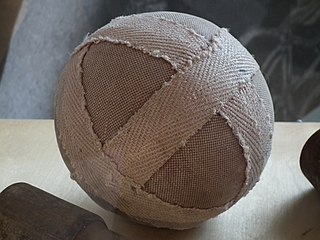horsehair

As horsehair the shorter and harder body hair as well as the tail- and mane of the horse and the ingredients material produced therefrom of tailoring and Skinning designated. It used to be collected for the market wherever horse breeding was practiced. It was first boiled with water and then worked on by panting and sorted by color.
In the past, the long hair was mainly used to make wigs worn by women and men of the nobility . The short hair was twisted into braids (Krull or Kroll hair) and used as cushioning material , as a filling for mattresses , horsehair pillows and riding saddles or in tailoring as an insert. Medieval Spanish bowler hats were often padded with horsehair. Blankets woven entirely from horsehair were also made. In addition, horsehair was processed by the sieve makers, and fishing lines were made from it in the fishing industry . The classic upholstery material is still used today. In the case of fully upholstered mattresses, the bounce is increased even further by a superheated steam treatment. It is also used for brushes and horsehair brooms, it remains at least superior to synthetic fibers in the ability to straighten up.
A particular area of application for horsehair is stringing bow ties .
Up until a few years ago, horsehair inlays were used in classic tailoring and skinning for the padding of the front parts of jackets or coats . To do this, the hair twisted into pigtails was either torn by hand or frayed with a carding machine ( Krempelbock ), the result is an almost springy, very elastic product. In the skinning, the horsehair fabric was used, among other things, in the main period of muffle fashion , mostly in mass production in ready-made clothing , together with cotton wool instead of down bags .
Horsehair cannot be spun on its own, but only by spinning it with cotton can it be formed into an endless weft yarn ("twisted horsehair"). Horsehair thread interwoven with linen thread was traded in the clothing trade as horsehair insert or simply as "horsehair". It was connected to the outer fabric by hand ( pricking stitch ) , especially for the front and lapels. This elaborate form of processing was only used for high-quality clothing, the high bounce of the horsehair gave the part a permanent smooth fall. Instead of natural horsehair, more and more viscose- based synthetic horsehair ( crinol ) is used. The Italian-French term crinoline for the spread petticoat refers to the material used for the stiffening, it means "horsehair fabric".
Because of its special properties, horsehair is also used in the upholstery industry. Here it describes an outer fabric made of around 70% horsehair ( weft ) with a warp thread made of cotton, polyester or silk. Used more often in the past, it is still needed today for refurbishing old and very high-quality new upholstered furniture and as wall covering for representative old rooms. Because of the mostly dark horsehair, the possible color palette is limited and the fabrics are mainly produced in darker colors. In addition, horsehair is used as a filling material in upholstery; the hair puller is used to prick under the canvas and distribute the horsehair evenly.
With twisted horse hair , the weft consists of an endless thread twisted with cotton thread, which no longer has to be inserted into the shed by hand. Because of the twisting, the horsehair no longer works its way out so easily.
In addition to many other uses, horsehair is also used for perchten costumes . In the traditional lacquer art of Myanmar , a horsehair braid is used as a carrier material for the finest lacquer work, in order to give drinking vessels in particular greater flexibility.
With the bike ball , the ball is filled with pressed elk or horsehair and therefore hardly bounces
Web links
- Material archive: Horsehair - material information and pictures
Literature and individual references
- ^ A b c Alfons Hofer: Textile and Model Lexicon , Deutscher Fachverlag, Frankfurt / Main, 7th edition, Volume 2, 1997, Roßhaar , p. 756
- ↑ Ingeborg Heider: 42 million meters of interlining material per year . In: Die Pelzwirtschaft No. 1, CB-Verlag Carl Boldt, Berlin January 25, 1978, p. 16.
- ↑ Alexander Tuma: Pelz-Lexikon. Fur and rough goods . XXI. Tape. Verlag Alexander Tuma, Vienna 1951. Roßhaar , pp. 47–48
- ↑ Rosshaarstoff.com
- ↑ Alfons Hofer: Textile and Model Encyclopedia , Deutscher Fachverlag, Frankfurt / Main, 7th edition, Volume 2, 1997, Zwirnrosshaar , page 1060
- ↑ http://steiermark.orf.at/news/stories/2606894/ Cut off the mane and tail of horses . ORF.at October 2, 2013. Last accessed October 2, 2013
- Meyers Konversationslexikon, article horsehair , ca.1895
- Economic Encyclopedia von Krünitz, article horse hair



